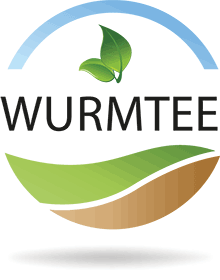Die Rolle des Wurmhumus in der höheren Bodenfruchtbarkeit
Einfluss von Wurmhumus auf die Bodenfruchtbarkeit durch Mikro- und Makroelementen, Vitaminen, Enzymen und Hormonen:
- Kale RD, Mallesh BC, Bano K, Bagyaray DJ (1992) Influence of vermicompost application on the available macronutrients and selected microbial populations in paddy field. Soil Biol Biochem 24:1317-1320
- Kalembasa D (1996) The influence of vermicomposts on yield and chemical composition of tomato. Zesz Probl Post Nauk Roln 437:249-252
- Edwards CA (1988) Breakdown of animal, vegetable and industrial organic wastes by earthworms. In: Edwards CA, Neuhauser EF (eds) Earthworms in Waste and Environmental Management SPB, The Hague, Netherlands. pp 21-3
- Sinha RK, Herat S, Valani D, Chauhan K (2009) Vermiculture and sustainable agriculture. Am-Euras J Agric and Environ Sci, IDOSI Publication 5:1-55
- Makulec G (2002) The role of Lumbricus rubellus Hoffm. In determining biotic and abiotic properties of peat soils. Pol J Ecol 50:301-33
Im Wurmhumus sind Nährstoffe, wie Nitrate, austauschbarer Phosphor, lösliches Kalium, Calcium und Magnesium in pflanzenverfügbarer Form enthalten (Anstieg der Aufnahme von Nährstoffen).
- Orozco FH, Cegarra J, Trujillo LM, Roig A (1996) Vermicomposting of coffee pulp using the earthworm Eisenia fetida: effects on C and N contents and the availability of nutrients. Biol Fertil Soils 22:162-166
- Edwards CA (1998) The use of earthworms in the breakdown and management of organic wastes. In: Edwards CA (ed) Earthworm Ecology, CRC Press, Boca Raton. pp 327-354
- Shi-wei Z, Fu-zhen H (1991) The nitrogen uptake efficiency from 15N labeled chemical fertilizer in the presence of earthworm manure (cast). In: Veeresh GK, Rajagopal D, Viraktamath CA (eds) Advances in Management and Conservation of Soil Fauna, Oxford and IBH publishing Co, New Delhi. pp 539-542
Verbesserte Aufnahme von Nährstoffen aus konventionellen Düngemittel mit Beimischung von 50% Wurmhumus im Dünger:
- Jadhav AD, Talashilkar SC, Pawar AG (1997) Influence of the conjunctive use of FYM, vermicompost andurea on growth and nutrient uptake in rice. J Maharashtra Agric Univ 22:249-25
- Sreenivas C, Muralidhar S, Rao MS (2000) Vermicompost, a viable component of IPNSS in nitrogen nutrition of ridge gourd. Ann Agr Res 21:108-113
- Edwards CA, Bohlen PJ (1996) Biology and Ecology of earthworms. Chapman and Hall, London. p 426
- Atiyeh RM, Arancon NQ, Edwards CA, Metzger JD (2000) Influence of earthworm- processed pig manure on the growth and yield of green house tomatoes. Bioresour Technol 75:175-180
Verbesserung der Bodenstruktur, Fruchtbarkeit, das Pflanzenwachstum; Erhöhung des Ernteertrages und Unterdrückung der Krankheiten, die durch bodenbürtige Pflanzenpathogene verursacht werden:
- Chaoui H, Edwards CA, Brickner M, Lee S, Arancon N (2002) Suppression of the plant diseases, Pythium (damping off), Rhizoctonia (root rot) and Verticillum (wilt) by vermicomposts. Proceedings of Brighton Crop Protection Conference – Pests and Diseases II(8B-3):711-71
- Scheuerell SJ, Sullivan DM, Mahaffee WF (2005) Suppression of seedling damping-off caused by Pythium ultimum, and Rhizoctonia solani in container media amended with a diverse range of Pacific Northwest compost sources. Phytopathology 95:306-315
- Singh R, Sharma RR, Kumar S, Gupta RK, Patil RT (2008) Vermicompost substitution influences growth, physiological disorders, fruit yield and quality of strawberry (Fragaria x ananassa Duch.). Bioresour Technol 99:8507-8511
- Kale RD (1995) Vermicomposting has a bright scope. Indian Silk 34:6-9
Positive Auswirkungen von Wurmhumus auf Feldfrüchten:
- Chan LPS, Griffiths DA (1988) The vermicomposting of pretreated pig manure. Biol Wastes 24:57-69
- Arancon NQ, Edwards CA, Bierman P, Welch C, Metzger JD (2004) The influence of vermicompost applications to strawberries: Part 1. Effects on growth and yield. Bioresour Technol 93:145-153
- Edwards CA, Burrows I (1988) The potential of earthworm composts as plant growth media. In: Edwards CA, Neuhauser E (eds) Earthworms in Waste and Environmental Management, SPB Academic Press, The Hague. pp 21-32
- Wilson DP, Carlile WR (1989) Plant growth in potting media containing worm-worked duck waste. Acta Hortic 238:205-220
- Subler S, Edwards CA, Metzger PJ (1998) Comparing vermicomposts and composts. Biocycle 39:63-66
- Atiyeh RM, Subler S, Edwards CA, Bachman G, Metzger JD, Shuster W (2000) Effects of vermicomposts and composts on plant growth in horticulture container media and soil. Pedobiologia 44:579-590
Positive Wirkung von Wurmhumus auf Zier- und Blütenpflanzen:
- Edwards CA, Burrows I (1988) The potential of earthworm composts as plant growth media. In: Edwards CA, Neuhauser E (eds) Earthworms in Waste and Environmental Management, SPB Academic Press, The Hague. pp 21-32
- Atiyeh RM, Arancon NQ, Edwards CA, Metzger JD (2000) Influence of earthworm- processed pig manure on the growth and yield of green house tomatoes. Bioresour Technol 75:175-180
Positiver Einfluss auf PH-Wert, Mikrobenpopulation, Bodenenzymaktivitäten und Verringerung des Anteils der wasserlöslichen Chemikalie die Umweltverschmutzungen verursachen:
- Maheswarappa HP, Nanjappa HV, Hegde MR (1999) Influence of organic manures on yield of arrowroot, soil physico-chemical and biological properties when grown as intercrop in coconut garden. Ann Agr Res 20:318-323
- Mitchell A, Edwards CA (1997) The production of vermicompost using Eisenia fetida from cattle manure. Soil Biol Biochem 29:3-4
Reduzierung von Schäden, verursacht durch Phytotoxizität von überschüssigen Nährstoffen:
- Subler S, Edwards CA, Metzger PJ (1998) Comparing vermicomposts and composts. Biocycle 39:63-66
Wurmhumus als Bodenverbesserer und Langzeitdünger:
- Albanell E, Plaixats J, Cabrero T (1988) Chemical changes during vermicomposting (Eisenia fetida) of sheep manure mixed with cotton industrial wastes. Biol Fertil Soils 6:266-269
- Atiyeh RM, Dominguez J, Subler S, Edwards CA (2000) Changes in biochemical properties of cow manure during processing by earthworms (Eisenia andrei, Bouché) and the effects on seedling growth. Pedobiologia 44:709-724
Reduktion der Aufnahme von schädlichen Schwermetallen in Pflanzen durch Bildung von komplexen polymerisierten Aggregaten in für Pflanzen nicht verfügbarer Form:
- Dominguez J, Edwards CA (2004) Vermicomposting organic wastes: A review. In: Shakir Hanna SH, Mikhail WZA (eds) Soil Zoology for sustainable Development in the 21st century, Cairo. pp 369-395
- Kolodziej M, Kostecka J (1994) Some qualitative features of the cucumbers and carrots cultivated on the vermicompost. Zeszyty Naukowe Akademii Rolniczej W Krakowie 292:89-94


